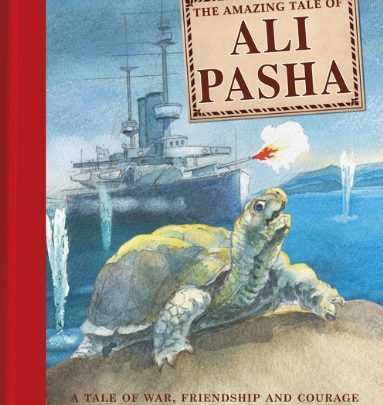KS2 Book Topic - The Amazing Tale of Ali Pasha

A tortoise waking up might not sound the most thrilling topic starter, but the slumbering reptile in The Amazing Tale of Ali Pasha has an account of WWI that begs to be told, and retold The writer and illustrator Michael Foreman grew up during World War II in a world inhabited by soldiers, sailors and […]

A tortoise waking up might not sound the most thrilling topic starter, but the slumbering reptile in The Amazing Tale of Ali Pasha has an account of WWI that begs to be told, and retold
The writer and illustrator Michael Foreman grew up during World War II in a world inhabited by soldiers, sailors and American GIs. Perhaps, then, it is unsurprising he has gone on to create a number of stories featuring war as the backdrop, including War Boy and War Game.
Now, over 100 years on from the start of World War I, Foreman introduces us to a new, rather unlikely hero – a tortoise named Ali Pasha. Based on a true story, the tale of Ali Pasha is revealed through flashbacks and journal entries that chart his journey from the battlefield of Gallipoli to a small village in Suffolk. Interspersed with evocative illustrations and exploring themes of heroism, friendship and triumph over adversity, the text is the perfect introduction to World War I history for children – not to mention an engaging story for readers of any age. Depending on the themes you choose to develop, it can be the basis of a powerful book topic for both lower and upper Key Stage 2.
1 Set up a newsroom
The story begins with Trevor, a junior reporter (or, in his words, “office boy”) working on a local newspaper in the 1950s. Trevor is entrusted with small stories such as weddings and the local village show; on this occasion, he is asked to “pop along and check on Mr Friston’s tortoise…See if it’s awake yet.” He sets out on his bicycle, imagining this to be yet another minor feature, but it soon becomes clear it’s anything but.
Immerse the children in Trevor’s world by setting up your own newspaper office in the classroom where they will become writers, editors and photographers – covering events within your school and from the text. This area should include laptops; notebooks; access to cameras and recording equipment; ‘news’, ‘sports’ and ‘entertainment’ sections; a selection of photographs and headlines children can self-select for writing opportunities; examples of different newspapers; and a pinboard for ‘breaking news’ (this will be added to as the topic progresses and the children learn more of Mr Friston’s – AKA Henry – and Ali Pasha’s adventures).
2 The plot
When Trevor first meets Henry Friston in 1950, he sees only an old man who lives in a converted railway carriage and tends to his garden and pet tortoise. However, as Trevor talks to Mr Friston, he quickly becomes intrigued by why a tortoise waking from hibernation is considered newsworthy.
Over a series of Sundays, Trevor visits the two compatriots and hears the story of how they came to meet during Henry’s active service in 1915 – though the story begins much earlier, with a young Henry mesmerised by a map of the world at school. At that age, Henry could hardly have imagined how much of that world he would soon visit – although neither could he have imagined the horror of the war in which he would take part.
On the 12th August 1913, Henry joined the Royal Navy, which led to a posting as Able Seaman on HMS Implacable. Serving aboard this warship, Henry travelled much of the world, eventually finding himself part of a wave of men sent ashore in May 1915 to join the battlefield of ‘X Beach’ Gallipoli. During his 10 days in ‘hell’, Henry carried wounded men to safety whilst dodging bullets and shells. But amidst the chaos he met his saviour, Ali Pasha: a tortoise Henry later smuggled back on board the HMS Implacable, and who would become an invaluable part of the Number Two Gunners team – acting as mascot and providing hope in what were often hopeless times.
3 Writing opportunities
Journal writing Interwoven throughout the text are fictionalised extracts from the journal Henry kept during his time in the navy. Support your class in analysing Henry’s use of journal-writing conventions: dates; the use of the first person; opening sentences as a ‘topic sentences’ (which does the same job as a sub-heading, introducing the subject to the reader); the use of dashes to add a comment (e.g. Would you know it – we’re at war with Germany!); exclamations (kaboom!); questions (Wonder where we’ll be sent?); quotations (“Hostilities will commence at midnight,” he said); and brackets to add additional information/alternative vocabulary – We’re landing heavy fire on the Germans (‘Fritz’, as Long John calls them). (The entry dated 4 August/31 October 1914 gives some particularly good examples.)
Having created success criteria, you could take a later diary entry, identify the main events as bullet point and then ask the children to write in role as Henry recounting his story.
To develop this learning further, provide each child with his or her own journal. Encourage children to begin this in class, but then continue in their own time – writing for purpose, but self-directed. For some children this will be one of the few times they write something that has not been prescribed by a teacher.
Creating tension In March 1915, HMS Implacable was ordered to sail to Gallipoli as part of a secret mission. It was accompanied by the HMS Queen and the two boats silently slid from their moorings after dark and glided out into the Atlantic. The boats were sent under ‘sealed orders’, which meant even the commanding officer did not know exactly what to expect. Only once the ship was out in the open sea was he allowed to open the sealed envelope containing his orders.
Use this situation to create a writing opportunity with the children by sealing a set of orders that can be used to drive their own story writing. The instructions might read as follows: You are to proceed with haste through the straits of Gibraltar until you reach Gallipoli. You are to enter into combat with the Turks and disable their guns on the shore and their planes in the sky. Your crew will form a landing party and enter into the combat on shore and to take control of the area beyond the cliffs.
Contrast poems Henry reflects on the contrast between the atmosphere of X Beach at Gallipoli and the beach near his home: “The beach was my place to smell the salty air, to listen to the call of the gull and whispering waves. At this beach – X Beach – there were no seagulls. You’d never hear birdsong here, only the screams of the wounded and dying soldiers and the clatter of foreign fire, shells and shrapnel”.
Work with your class to support them in writing a two-verse contrast poem. Begin by playing a clip of sounds from a native beach (YouTube has some great examples – but just let them hear the sounds first). Ask the children to draw a timeline across a blank piece of paper and identify the different sounds they hear (seagulls, waves etc) at different times, then ask them to add vocabulary to describe the sounds. Finally, watch the video and identify other elements found on the beach (sand, rocks, children and so on).
Repeat this activity with a clip from the Gallipoli campaign (search on YouTube for ‘The Battle Of Gallipoli. Rare Film Footage’). The notes pupils have made can then form a basis of two contrasting poems – they can write a descriptive sentence for each sound or object identified.
To extend more able pupils, they could alternate lines between the two different scenarios, e.g. Waves dance across the baking sand / Waves invade, stealing sand’s territory.
4 Cross-curricular opportunities
World map By following the journey made by the young Henry Friston during the course of the war, children will get a perspective on the distances between different places and changes in climate and landscape. At the beginning of the topic, display a large world map; this can be annotated on an ongoing basis to provide a physical record of Henry (and later Ali’s) exploits. Perhaps you could task a particular group of children with noting dates / places as the story progresses and put them in charge of keeping the map updated. Equally, in the news role-play area, provide opportunities for children to write newsflashes and weather reports for the different locations through which he journeys.
School allotment Much of the story is told by Mr Friston as he tends his garden, with Ali Pasha looking patiently on. The text constantly returns to this idyllic pastoral scene, contrasting the horrors that Henry’s younger self observed with the tranquillity of the life he has made for himself in his later years. If your school grounds allow it, the creation of a teaching allotment will not only enliven any playground, but it will also help children develop skills outside the classroom.
Children are fascinated by the process of how things grow and are even more excited by being able to taste what they have harvested – which is why allotment gardening is perfect for curious minds and mouths. The National Allotment Society provides helpful advice on setting up an allotment and also guidance on suitable plants to grow. The Kitchen Garden Project organised by Jamie Oliver also suggests some great activities and recipes to turn the fruits (and vegetables) of the children’s labour into delicious meals.
Ditty box Henry shares with Trevor the contents of his ‘ditty box’: a wooden casket given to each of the sailors in which to keep their personal items (there’s a picture of this on page 27 of the text). It is obvious from how it has been looked after that, to Henry, this was truly precious. Over time he reveals the different items he has saved – including postcards, letters, his journal, his naval hat band and photographs.
Discuss with your class why Henry would consider these items valuable and then move them on to the task of creating their own ditty boxes. Shoeboxes are the ideal size for this – coat with papier mache to increase sturdiness and then use online images to inspire decoration. Ask each child to consider what to put in her own box – if she was journeying a long distance, what items would she want to remind her of home? What might she collect as keepsakes whilst travelling?
Bringing the topic to a close This story travels full circle, ending once more in a village in Suffolk with the question, “Is Ali Pasha awake?” However, the text itself does not finish there. Michael Foreman shares with the reader his own experience of meeting Henry Friston when growing up in rural Suffolk. He then goes on to highlight how Ali found fame, inspiring a number of national and international newspaper stories and appearing on Blue Peter to be awarded with his own Blue Peter badge!
Now that the class have become experts on the exploits of Henry and Ali, bring the topic to the close by staging your own media frenzy. Challenge different groups to role-play and stage television interviews, news conferences, chat shows and perhaps even the presentation of the coveted Blue Peter badge. Use all of these experiences to contribute towards children ghost writing Trevor’s eventual newspaper article, ‘The Amazing Tale of Ali Pasha’.
Learning beyond the classroom
One of Henry’s tasks at Gallipoli is to carry fallen soldiers back to the field hospital to receive treatment. The Red Cross Website (redcross.org.uk) provides activities for teachers to use with children to help them respond in an emergency. Alternatively, you could arrange for your school nurse to run a course for your class on CPR and first aid. Trevor’s trusty bicycle is his chosen method of transport. Ensure your pupils know how to be safe by offering a bikeability course in school. Contact Bikeability for more details.












